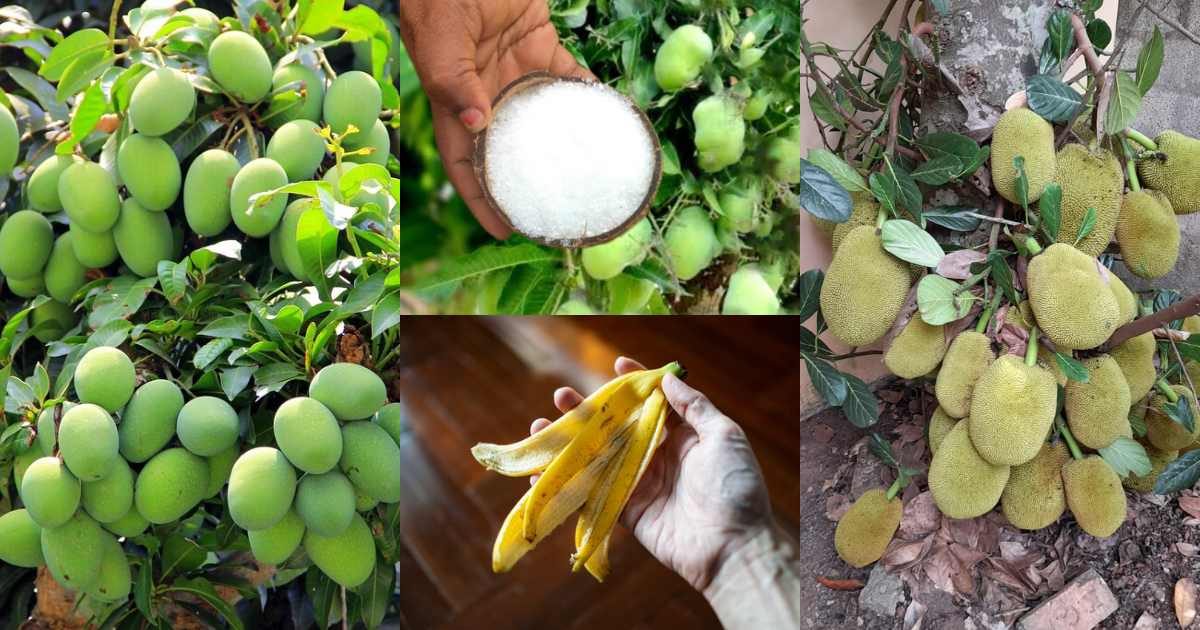
പഴതൊലിയും ഉപ്പും മാത്രം മതി! ഈ ഒരു സൂത്രം ചെയ്താൽ ഏത് കായ്ക്കാത്ത മാവും പ്ലാവും കൊമ്പൊടിയും വിധം കുലകുത്തി കായ്ക്കും!! | Mango Cultivation Using Salt and Banana Peel
Mango Cultivation Using Salt and Banana Peel
Mango Cultivation Using Salt and Banana Peel : മാങ്ങയുടെയും, ചക്കയുടെയും സീസണിൽ പരമാവധി അത് ഉപയോഗിച്ച് വിഭവങ്ങൾ ഉണ്ടാക്കാൻ ഇഷ്ടപ്പെടുന്നവർ ആയിരിക്കും മിക്ക ആളുകളും. മാത്രമല്ല ആ ഒരു സമയം കഴിഞ്ഞാലും ചക്കയും മാങ്ങയും പല രീതിയിൽ സൂക്ഷിച്ചുവയ്ക്കാനുള്ള വഴികളും എല്ലാവരും നോക്കാറുണ്ട്. എന്നാൽ ഇങ്ങനെ സൂക്ഷിച്ചു വെക്കണമെങ്കിൽ ആവശ്യത്തിനു കായ്ഫലങ്ങൾ ഉണ്ടാകേണ്ടത് അത്യാവശ്യമാണ്.
മാങ്ങയും ചക്കയും ആവശ്യത്തിന് ഉണ്ടാകാനായി മരത്തിൽ പ്രയോഗിക്കാവുന്ന ഒരു കാര്യമാണ് ഇവിടെ വിശദമാക്കുന്നത്. എത്ര കായ്ക്കാത്ത ചെടികളും അതുപോലെ ഗ്രോ ബാഗിൽ വളർത്തിയെടുക്കുന്ന ചെടികൾ പോലും ഈയൊരു രീതിയിൽ പ്രയോഗിച്ചാൽ ആവശ്യത്തിന് ഫലങ്ങൾ തരും. അതിനായി ആദ്യം ചെയ്യേണ്ടത് ഒരു പ്ലാസ്റ്റിക് ബോട്ടിലെടുത്ത് അതിലേക്ക് ഒന്നര ലിറ്റർ അളവിൽ കഞ്ഞിവെള്ളം പുളിപ്പിച്ചത് ഒഴിക്കുക.
ശേഷം പഴത്തൊലി ചെറിയ കഷ്ണങ്ങളായി അരിഞ്ഞിടുക. ഇത് ഒന്നു മുതൽ രണ്ട് ആഴ്ച വരെ അടച്ച് സൂക്ഷിക്കണം. ഈയൊരു മിശ്രിതം അരിച്ച് ഡയല്യൂട്ട് ചെയ്താണ് ചെടികൾക്ക് താഴെ ഒഴിച്ചു കൊടുക്കേണ്ടത്. എന്നാൽ ഈയൊരു രീതി പ്രയോഗിക്കുന്നതിന് മുൻപായി മാവ് അല്ലെങ്കിൽ പ്ലാവിന്റെ തടം നല്ലതുപോലെ മണ്ണ് മാറ്റി വൃത്തിയാക്കി അതിന് ചുറ്റും വെള്ളമൊഴിച്ച് നനച്ച ശേഷം ഡോളോമേറ്റ് ഇട്ട് കൊടുക്കണം. ഇതിൽ നിന്നും ധാരാളം പൊട്ടാസ്യം ചെടിക്ക് ലഭിക്കുന്നതാണ്.
ഡോളോമേറ്റ് ഇട്ട് ഒരാഴ്ച കഴിയുമ്പോൾ എപ്സം സോൾട്ട് കൂടി ചെടിയിൽ തളിച്ച് കൊടുക്കണം. എപ്സം സോൾട്ട് ലായനി തയ്യാറാക്കാനായി ഒരു ചെറിയ പ്ലാസ്റ്റിക് ബോട്ടിൽ എടുത്ത് അതിൽ വെള്ളം ,മുക്കാൽ ടീസ്പൂൺ സാൾട്ട് എന്നിവ ചേർത്ത് നല്ലതുപോലെ മിക്സ് ചെയ്തു കൊടുക്കുക. ശേഷം ആവശ്യമുള്ള ചെടിയുടെ മുകളിൽ സ്പ്രേ ചെയ്ത് നൽകാവുന്നതാണ്. എല്ലാ ചെടികളിലും ഈയൊരു രീതി പ്രയോഗിക്കുകയാണെങ്കിൽ കീടാണുക്കളെ ഇല്ലാതാക്കാനും ചെടി നല്ലതുപോലെ കായ്ക്കാനും അത് നല്ലതാണ്. Mango Cultivation Using Salt and Banana Peel Video Credit : PRS Kitchen
Mango Cultivation Using Salt and Banana Peel | Organic High-Yield Tips
Mango is one of the most popular tropical fruits worldwide. Farmers and home gardeners are increasingly looking for organic, cost-effective ways to improve mango growth and fruit quality. Using salt and banana peel in mango cultivation is a proven method to enhance soil fertility, stimulate growth, and increase fruit yield.
This guide provides step-by-step tips for high-yield mango cultivation using these natural ingredients.
Why Use Salt and Banana Peel in Mango Cultivation?
- Banana peel: Rich in potassium, phosphorus, and essential nutrients that improve flowering, fruit setting, and fruit size.
- Salt (sodium chloride): When used carefully in small amounts, it can help prevent fungal diseases and boost nutrient absorption.
- Eco-friendly: Both ingredients are organic and chemical-free, ideal for sustainable farming.
- Cost-effective: Reduces dependency on synthetic fertilizers and enhances soil quality naturally.
Soil and Climate Requirements
- Soil: Well-drained sandy loam or loamy soil with pH 6–7.
- Climate: Tropical and subtropical regions; temperature range 24–35°C is optimal.
- Rainfall: 750–2500 mm; supplemental irrigation improves fruit quality.
Planting Mango Trees
- Spacing: 8–10 meters between trees for standard planting; 5–6 meters for high-density orchards.
- Pit preparation: Dig pits 1 m³ and fill with topsoil, compost, and banana peel pieces.
- Planting season: Pre-monsoon (March–May) or early monsoon for maximum survival.
- Watering: Ensure regular watering for young plants; reduce once trees establish.
Using Banana Peel in Mango Cultivation
- Chop banana peels into small pieces.
- Mix with compost or farmyard manure and place in the planting pit.
- For mature trees, bury banana peel pieces around the root zone once or twice a year to provide potassium and phosphorus for flowering and fruiting.
Using Salt in Mango Cultivation
- Use small amounts of rock salt or table salt (5–10 g per plant) during soil preparation or mix with water for foliar spray.
- Avoid excess salt, as high concentration can damage roots and reduce yield.
- Salt helps in enhancing nutrient absorption and can prevent certain fungal infections on leaves.
Fertilization & Nutrient Management
- Use organic manure along with banana peel for balanced nutrition.
- Apply NPK fertilizers according to the tree’s age:
- Young trees: Nitrogen-heavy (for vegetative growth)
- Mature trees: Phosphorus & Potassium-heavy (for flowering & fruiting)
- Monitor soil pH and add lime if the soil becomes acidic.
Pruning and Maintenance
- Remove dead and diseased branches regularly.
- Prune to open canopy for better sunlight penetration.
- Mulch the base with organic matter to retain moisture.
Pest and Disease Management
- Common pests: Mango hoppers, mealybugs, fruit flies.
- Common diseases: Powdery mildew, anthracnose.
- Control: Use neem-based sprays, copper fungicides, and maintain orchard hygiene.
Harvesting Tips
- Mango trees start fruiting 3–5 years after planting depending on the variety.
- Harvest when fruits are mature, aromatic, and firm.
- Handle carefully to avoid bruising; store at cool temperatures for longer shelf life.
Pro Tips for Success
- Use ripe banana peels for composting; avoid rotting or moldy peels.
- Apply salt sparingly; excessive use can harm soil microorganisms.
- Mulching and organic fertilizers improve fruit quality and tree health.
- Choose high-yielding varieties such as Alphonso, Kesar, or Himsagar for maximum profit.
